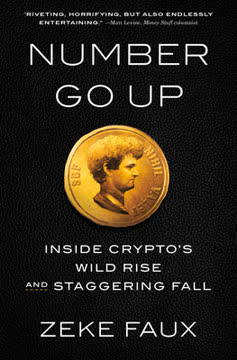Key Takeaways
1. Coinbase seized the open secret of making bitcoin accessible
Brian had grabbed an open secret of his own. He knew bitcoin could be a world-changing technology, but that buying it—for most people—was a confusing, convoluted experience. What if he could make it simpler?
Simplifying bitcoin access. Brian Armstrong recognized that while bitcoin had revolutionary potential, it was too complex for mainstream adoption. He built Coinbase to make buying and selling bitcoin as easy as online banking. This insight allowed Coinbase to grow rapidly as interest in cryptocurrency surged.
Early challenges. Despite its user-friendly approach, Coinbase faced significant hurdles in its early days:
- Skepticism from traditional financial institutions
- Regulatory uncertainty around cryptocurrencies
- Technical difficulties in securely storing and transferring digital assets
- Competition from established exchanges like Mt. Gox
The company overcame these obstacles through persistence, strategic partnerships, and a commitment to compliance. By positioning itself as a legitimate bridge between the traditional financial system and the world of cryptocurrency, Coinbase was able to attract both retail and institutional investors.
2. Regulatory challenges shaped crypto's early growth
Haun soon realized her FNU LNU was not a criminal mastermind, and that bitcoin was not intrinsically bad or good. Bitcoin was like another once-novel technology: paper money.
Evolving legal landscape. As cryptocurrencies gained popularity, regulators struggled to classify and govern them. Different agencies had conflicting views:
- IRS: Treated crypto as property for tax purposes
- SEC: Considered many cryptocurrencies to be securities
- FinCEN: Viewed crypto businesses as money transmitters
- CFTC: Classified bitcoin as a commodity
This regulatory uncertainty created both challenges and opportunities for companies like Coinbase. By proactively engaging with regulators and prioritizing compliance, Coinbase was able to build credibility and gain a competitive advantage over less scrupulous operators in the space.
Balancing innovation and regulation. The crypto industry had to navigate a fine line between pushing technological boundaries and adhering to existing financial regulations. This tension shaped the development of cryptocurrency businesses and infrastructure, forcing companies to innovate not just in technology, but also in legal and compliance strategies.
3. The block size debate sparked a civil war in bitcoin
The dispute between the big-blockers—those in favor of 2MB blocks—and small-blockers—who opposed them—soon devolved into an online version of salted-earth warfare.
Technical limitations fuel ideological divide. As bitcoin's popularity grew, its network became congested, leading to slow transaction times and high fees. This sparked a heated debate over how to scale the network:
- Big-blockers: Wanted to increase the block size to allow more transactions
- Small-blockers: Feared larger blocks would lead to centralization
The debate went beyond technical considerations, revealing fundamental ideological differences about bitcoin's future. It highlighted the challenges of governance in a decentralized system and the difficulty of achieving consensus among diverse stakeholders.
Consequences of the schism. The block size debate ultimately led to:
- Multiple hard forks, creating new cryptocurrencies like Bitcoin Cash
- Damaged relationships within the bitcoin community
- Increased competition from alternative cryptocurrencies
- Development of Layer 2 scaling solutions like the Lightning Network
This conflict demonstrated both the resilience and the limitations of bitcoin's decentralized governance model, shaping the future development of the entire cryptocurrency ecosystem.
4. Ethereum and ICOs fueled a speculative crypto bubble
In 2017, the media reported the arrest of the Dread Pirate Roberts—the mastermind behind the global drug bazaar known as the Silk Road. In a fit-for-Hollywood moment, disguised FBI agents tackled the Dread Pirate—aka Ross Ulbricht—in a San Francisco library and, critically, snatched away his laptop before he could close the cover and encrypt all the data it contained.
Rise of alternative cryptocurrencies. Ethereum's launch in 2015 introduced the concept of smart contracts, enabling a new wave of blockchain applications. This sparked the creation of hundreds of new cryptocurrencies and tokens, each promising revolutionary use cases. The ease of creating and selling these tokens through Initial Coin Offerings (ICOs) led to a speculative frenzy.
Bubble dynamics and consequences:
- Astronomical price increases: Bitcoin reached nearly $20,000 in December 2017
- Proliferation of dubious projects and outright scams
- Regulatory crackdown on ICOs and increased scrutiny of crypto exchanges
- Eventual market crash, with many cryptocurrencies losing over 90% of their value
The ICO boom and subsequent bust highlighted the volatile and speculative nature of the crypto market. It also drew increased attention from regulators and traditional financial institutions, accelerating the industry's maturation process.
5. Coinbase's success bred complacency as competitors emerged
"Coinbase got too comfortable," he adds. "At a board meeting, it was all about, 'How are we going to spend all this money in order to avoid a tax liability?'" In Olaf's view, Coinbase should have been exploring the new frontiers of crypto rather than perfecting its corporate finance game.
Challenges of rapid growth. Coinbase's early success and dominant market position in the U.S. led to a period of complacency. The company focused on:
- Improving internal processes and corporate structure
- Expanding into traditional financial services
- Maintaining regulatory compliance
While these efforts were important, they came at the cost of innovation and agility. This allowed new competitors, particularly Binance, to gain market share by offering a wider range of cryptocurrencies and more advanced trading features.
Binance's disruptive approach. CZ's exchange quickly overtook Coinbase in trading volume by:
- Offering a wider variety of cryptocurrencies
- Creating its own token (BNB) to incentivize usage
- Focusing on crypto-to-crypto trading to avoid regulatory hurdles
- Maintaining a lean, fast-moving organizational structure
Coinbase's slow response to these competitive threats highlighted the challenges of maintaining innovation and startup culture as a company grows and becomes more established.
6. Internal power struggles threatened Coinbase's dominance
Realpolitik replaced the idealism Brian had always tried to impart. This became even clearer in early 2019, when the company set out to buy a blockchain analytics service.
Competing visions for Coinbase's future. As the company grew, internal conflicts emerged between different factions:
- Crypto idealists vs. traditional finance professionals
- Focus on retail users vs. institutional clients
- Rapid expansion of cryptocurrency offerings vs. cautious regulatory approach
These tensions culminated in power struggles between key executives, including COO Asiff Hirji and CTO Balaji Srinivasan. The conflicts led to high turnover in the executive ranks and strategic inconsistencies.
Consequences of internal strife:
- Delayed product launches and missed opportunities
- Damaged company culture and employee morale
- Strategic missteps, such as the controversial Neutrino acquisition
- Forced Brian Armstrong to reassert control over the company
The internal conflicts at Coinbase reflected broader debates within the crypto industry about balancing innovation with regulation and maintaining core principles while pursuing mainstream adoption.
7. Bitcoin proved resilient as the broader crypto market matured
Bitcoin's resilience—the network has run without interruption for over ten years—resulted in yet more memes. "The Fed Wire is Down. Bitcoin is never down," tweeted a crypto fund manager and social media personality known as Pomp. He followed this with: "The stock market is closed. Bitcoin never closes."
Bitcoin's enduring dominance. Despite challenges and competition, bitcoin maintained its position as the leading cryptocurrency:
- Survived numerous price crashes and regulatory challenges
- Attracted institutional investors and corporate adopters
- Developed a robust ecosystem of supporting technologies and services
- Maintained its core value proposition of decentralization and censorship resistance
Bitcoin's resilience reinforced its status as "digital gold" and a store of value, even as other cryptocurrencies struggled to find sustainable use cases.
Maturation of the crypto industry. The experiences of the boom and bust cycle led to significant developments:
- Improved regulatory clarity in many jurisdictions
- Development of more sophisticated trading and custody solutions
- Increased interest from traditional financial institutions
- Growth of decentralized finance (DeFi) applications
- Emergence of stablecoins as a bridge between crypto and traditional finance
These developments set the stage for potential mainstream adoption of cryptocurrencies and blockchain technology, with companies like Coinbase playing a crucial role in bridging the gap between the crypto world and traditional finance.
Last updated:
FAQ
What's "Kings of Crypto" about?
- Focus on Coinbase: "Kings of Crypto" by Jeff John Roberts chronicles the journey of Coinbase, a startup that aimed to bring cryptocurrency from Silicon Valley to Wall Street.
- Cryptocurrency Evolution: The book explores the evolution of cryptocurrency, focusing on how Coinbase played a pivotal role in making digital currencies accessible to the general public.
- Key Figures and Events: It delves into the lives of key figures like Brian Armstrong and Fred Ehrsam, and significant events that shaped the crypto industry.
- Challenges and Triumphs: The narrative covers the challenges Coinbase faced, including regulatory hurdles and internal conflicts, as well as its triumphs in the crypto world.
Why should I read "Kings of Crypto"?
- Insight into Crypto World: The book provides a comprehensive look into the world of cryptocurrency, making it a must-read for anyone interested in digital finance.
- Startup Success Story: It offers an inspiring story of how a startup can overcome challenges and disrupt traditional financial systems.
- Understanding Market Dynamics: Readers gain insights into the market dynamics and the regulatory environment surrounding cryptocurrencies.
- Engaging Narrative: Jeff John Roberts presents an engaging narrative that combines business strategy, technology, and personal stories.
What are the key takeaways of "Kings of Crypto"?
- Coinbase's Impact: Coinbase played a crucial role in making cryptocurrency accessible to the masses, acting as a bridge between the tech-savvy and the general public.
- Regulatory Challenges: The book highlights the complex regulatory landscape that crypto companies must navigate to succeed.
- Innovation and Adaptation: It emphasizes the importance of innovation and adaptation in the rapidly evolving world of digital currencies.
- Leadership and Vision: The story underscores the significance of strong leadership and a clear vision in driving a startup's success.
What are the best quotes from "Kings of Crypto" and what do they mean?
- "Running through brick walls": This phrase, often used by Fred Ehrsam, symbolizes the relentless drive and determination required to overcome obstacles in the startup world.
- "Not your keys, not your coins": A common refrain in the crypto community, highlighting the importance of controlling one's private keys to truly own cryptocurrency.
- "The future of finance": A recurring theme in the book, suggesting that cryptocurrency and blockchain technology are set to revolutionize the financial industry.
- "Economic freedom for the world": Brian Armstrong's vision for Coinbase, emphasizing the potential of cryptocurrency to democratize finance globally.
How did Coinbase start and evolve according to "Kings of Crypto"?
- Founding Vision: Coinbase was founded by Brian Armstrong with the vision of making cryptocurrency accessible to everyone, not just tech enthusiasts.
- Y Combinator and Early Days: The company started with Armstrong's participation in Y Combinator, where he developed the idea of a user-friendly platform for buying and selling bitcoin.
- Growth and Challenges: Coinbase faced numerous challenges, including regulatory scrutiny and internal conflicts, but continued to grow and expand its offerings.
- Market Leadership: Over time, Coinbase established itself as a leader in the crypto space, becoming a trusted platform for millions of users.
What role did Brian Armstrong play in Coinbase's success?
- Visionary Leader: Brian Armstrong's vision of democratizing access to cryptocurrency was central to Coinbase's mission and success.
- Navigating Challenges: He played a key role in navigating regulatory challenges and ensuring Coinbase's compliance with financial laws.
- Building a Team: Armstrong was instrumental in building a strong team and fostering a culture of innovation and resilience at Coinbase.
- Strategic Decisions: His strategic decisions, such as expanding Coinbase's offerings and entering new markets, were crucial to the company's growth.
How did regulatory challenges impact Coinbase as described in "Kings of Crypto"?
- IRS Subpoena: Coinbase faced a significant challenge when the IRS issued a subpoena for customer records, leading to a legal battle over privacy and compliance.
- Navigating Regulations: The company had to navigate a complex regulatory landscape, balancing compliance with its mission to provide easy access to cryptocurrency.
- State and Federal Laws: Coinbase dealt with varying state and federal regulations, including the BitLicense in New York, which affected its operations.
- Advocacy and Lobbying: The book highlights Coinbase's efforts in advocacy and lobbying to shape favorable regulations for the crypto industry.
What is the significance of the "block size war" in "Kings of Crypto"?
- Scaling Debate: The block size war was a significant debate within the bitcoin community about how to scale the network to accommodate more transactions.
- Big-Blockers vs. Small-Blockers: The conflict was between those who wanted to increase the block size (big-blockers) and those who opposed it (small-blockers).
- Impact on Coinbase: Coinbase, led by Brian Armstrong, supported the big-blocker side, which led to tensions with other factions in the crypto community.
- Broader Implications: The war highlighted the challenges of governance and consensus in decentralized networks like bitcoin.
How did Ethereum's introduction affect the crypto landscape according to "Kings of Crypto"?
- Smart Contracts: Ethereum introduced the concept of smart contracts, allowing for programmable transactions on the blockchain, which expanded the use cases for cryptocurrency.
- Rival to Bitcoin: Ethereum emerged as a significant rival to bitcoin, offering more versatility and attracting a large developer community.
- ICO Boom: The platform facilitated the ICO boom, enabling new projects to raise funds by issuing tokens on the Ethereum blockchain.
- Coinbase's Response: Coinbase eventually added Ethereum to its platform, recognizing its growing importance in the crypto ecosystem.
What lessons does "Kings of Crypto" offer about startup culture and leadership?
- Adaptability: The book emphasizes the importance of adaptability and resilience in the face of challenges and changing market conditions.
- Vision and Execution: A clear vision, combined with effective execution, is crucial for a startup's success, as demonstrated by Coinbase's journey.
- Team Building: Building a strong, cohesive team is essential, and leaders must foster a culture of innovation and collaboration.
- Learning from Mistakes: The narrative highlights the value of learning from mistakes and continuously improving strategies and operations.
How does "Kings of Crypto" portray the relationship between Silicon Valley and Wall Street?
- Cultural Differences: The book explores the cultural differences between the innovative, risk-taking ethos of Silicon Valley and the traditional, conservative nature of Wall Street.
- Bridging the Gap: Coinbase's journey represents an effort to bridge the gap between these two worlds, bringing cryptocurrency to mainstream finance.
- Mutual Influence: The narrative shows how both Silicon Valley and Wall Street have influenced each other, with tech companies adopting financial practices and vice versa.
- Future Collaboration: The book suggests that future collaboration between these sectors could drive significant innovation in the financial industry.
What future trends in cryptocurrency does "Kings of Crypto" predict?
- Mainstream Adoption: The book predicts that cryptocurrency will continue to gain mainstream adoption, driven by technological advancements and regulatory clarity.
- Decentralized Finance (DeFi): It highlights the potential of DeFi to revolutionize traditional financial services by offering decentralized alternatives.
- Stablecoins and Digital Currencies: The narrative discusses the rise of stablecoins and digital currencies, which could reshape global finance.
- Ongoing Innovation: The book emphasizes the importance of ongoing innovation and the potential for new technologies to emerge and disrupt existing systems.
Review Summary
Kings of Crypto chronicles Coinbase's journey in the cryptocurrency world, offering insights into the company's founding, growth, and challenges. Readers appreciate the book's accessible narrative style and its coverage of key crypto events and figures. While some find it entertaining and informative, others criticize its focus on narrative over accuracy. The book provides a good overview of Coinbase's history and the broader crypto landscape, though some readers note it may already feel outdated due to the rapidly evolving nature of the industry.
Similar Books










Download PDF
Download EPUB
.epub digital book format is ideal for reading ebooks on phones, tablets, and e-readers.




